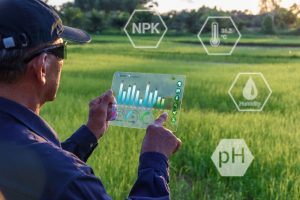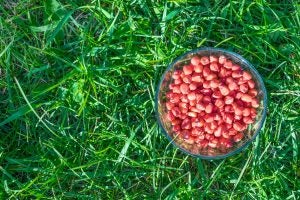The agriculture industry is, as the name suggests, an “industry.” Today’s farmers aren’t just working the land for their own benefit; they’re providing food to the population at large. Growing food at such high volumes requires a lot of cost and labor — which is why many farmers strive to increase the yield on their high-value crops.
If ag retailers can help their farmers grow more high-value crops such as food crops, they can expect to earn a more significant profit — both for themselves and the farmer. More money allows them to purchase the water, fertilizer, and other tools they need to improve their crop and yield. It’s a cycle that can be very profitable — but how can you and your grower make sure that the high-value crops produce large enough gains?
There are many ways to improve crop yields, from soil and moisture management to varying the seed used. Yield mapping, or yield monitoring, should be done before anything else. This data collection and analysis method has been around since the 1990s, but it’s still one of the best ways to help growers create crop plans for the greatest success.
As an ag retailer, you can leverage yield mapping to help your farmers produce greater yields, eliminate waste, and increase profits.

Benefits of yield mapping
Yield mapping uses a variety of tools to test the quality of the land. These results are then combined with GPS data to create a digital map of the acreage. This data is a significant benefit to growers, as they can use this data to get the most out of their land and crops.
Water content of soil
Soil water is the unsung hero of the agriculture industry and is often a significant crop yield factor — more than almost any other nutrient. This is because soil water is both a nutrient for plants and a carrier, helping other nutrients reach growing crops.
With yield mapping, growers get a clear picture of the water content in every square inch of their soil. This picture may be surprising because water content can vary wildly throughout a piece of land. One area of the land may have ample moisture, but a few feet away, the soil may be dry as a bone.
Thanks to yield mapping, there’s now a clear picture of which areas need extra water. You can then target the lacking areas and ensure that the soil has enough moisture using this information. Targeted treatment also means that you don’t accidentally waste water.
Determine appropriate amount of fertilizer
Another way yield mapping can help growers improve their crops is by recording the nutrient levels in their soil. Like water content, nutrient levels can be vastly different from one side of a field to the other. If a farmer hopes to get maximum yield across their land, all the soil must be as rich as possible.
Before this type of mapping, a farmer might buy large quantities of fertilizer and spread it across the entire field. Unfortunately, this method can be more wasteful than practical — particularly if most of the soil doesn’t need a lot of fertilization.
Yield mapping is essential if growers are using Variable Rate Technology (VRT) on their farm. These tools make it easy to apply water, fertilizer, and chemicals across the field at different rates — but without them, growers won’t know how much product to use in which area.
Having a clear understanding of the land’s soil allows growers to be more deliberate with their fertilizer. By only adding it to the parts of the land that need it, growers can make sure that their crops grow in the best possible conditions (and they’ll likely save money on fertilizer costs, too).

Choose the best hybrid
Most farmers and ag retailers use hybrids to boost their profits through greater yield, improved color, or some other benefit that results in a better crop. However, the wrong hybrid can wreak havoc on the soil, killing its fertility rate in the long term.
Yield mapping gives ag retailers great insight to help growers better understand their field and also allows them to understand which hybrids will suit it. Monitoring the soil makes it much easier to choose the hybrid that will succeed — or, if there is one hybrid that growers want or need to plant, they can treat their soil strategically to prime it for planting.
Discover under-performing and top performing areas
Sometimes, yield mapping leads you to discover a part of the land that doesn’t live up to its potential. It doesn’t matter if you have all the tools in the world, all the best seeds, and the most careful planning and planting process — if you’re in an under-performing area, you’re going to get less at harvest time.
If you or your farmer doesn’t know which parts of a field are underperforming (or, by contrast, which areas are thriving), you can’t guarantee a decent harvest for their high-value crops. But with yield mapping (which also monitors and records the yields in an area from each harvest), you can help them figure out which parts of their land bring in the most crops.
Plant the high-value crops in those parts, and presto — instantly improved yields!
Invaluable data
At the end of the day, yield mapping offers farmers and ag retailers a vital tool: knowledge. The monitoring tools you can access can measure and record data on moisture content, soil nutrients, and so much more. This data is invaluable, as it gives a grower the keys to unlocking their farm’s potential.
Yield mapping can change the way farming is done, taking the guesswork out of planting, fertilizing, and watering. The result? Lower growing costs, better yields, and higher profits for both the farmer and ag retailer. If you ask us, monitoring field health through mapping is a no-brainer for any grower in the ag industry — and ag retailers can benefit their growers by helping them start the process on their farms.
The monitoring tools you can access can measure and record data on moisture content, soil nutrients, and so much more.
Christina Trimis is the Content Marketing Manager at Growers, a leading technology partner empowering all of agriculture to thrive through powerful grower relationship tools. Trimis has a B.A. in Anthropology, with a specific focus in Environmental Anthropology, giving her unique insight into how agriculture affects communities. When she isn’t writing pithy commentary on the ag industry, she’s raging a one-man battle against oxford comma non-believers.



